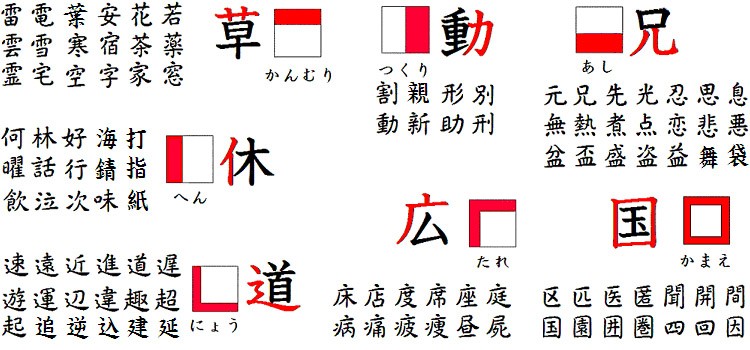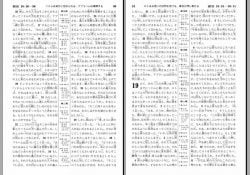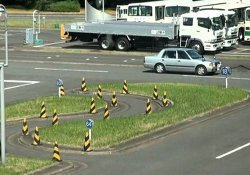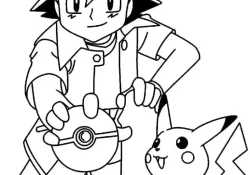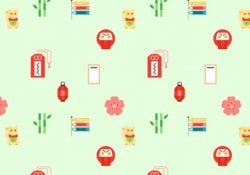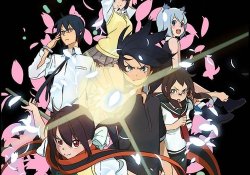Kanji are classified in dictionaries according to their main components. These components are called Radical (roots) in English and 部首 (bushu) in Japanese. Its original Japanese name is composed with the Kanji 部 which means division, section, group and with kanji 首 which means head or neck.
Radicals are kanji or elements that are found in the structure of an ideogram. Many think that a kanji is made up of several radicals, to a certain extent yes. However, each kanji has only one radical which is its head. This stem may or may not have a bearing on the final meaning of the kanji word. The radicals are not named and not all have a meaning of their own, currently there are about 214 radicals.
How is a Kanji formed using Radicals? See below radicals being applied and forming different Kanji:
- 時 - The root of this kanji is "sun" 日 - The kanji meaning is "time";
- 詩 - The root of this kanji is "word" 言 - The meaning of the kanji is "poetry, poem";
- 持 - The root of this kanji is "hand" 扌 - The kanji's meaning is "to hold",
Note that the hand stem 扌 is not the same as 手. This is because not all radicals are being used in the Japanese language, most are just used to form the kanji. You should also know that Japanese is full of ideograms that have the same meaning.
Classification of Radicals - Position
Radicals are usually classified by the position they are in the kanji, knowing this position will make them easier to use.
| Japanese | Position |
| hen | left side |
| tsukuri | right side |
| かんむり (kanmuri) -> Crown | on top |
| Leg | below |
| かまえ (kamae) | surround the kanji from the outside in |
| たれ (tare) | covers the kanji from top to bottom. |
| にょう (nyou) | left side also encompassing the underside of the kanji. |
The image below will show examples of kanji and the positions of their stems.
What are the benefits of knowing Japanese Radicals?
It is important to have knowledge of these elements that make up the kanji, so that it is easier to find a particular kanji in a dictionary and even understand the essence of its meaning.
Another advantage is that over time, you will be able to identify meaning in the ideograms and you will no longer see only traces. Knowing these elements helps you remember kanji and its meaning.
We know that several words in the Japanese language are the junction of kanji, for example: 手紙 (carta) is the junction of the ideograms of hand (手) and paper (紙). The same thing happens with radicals. See some examples:
- The Kanji and Radical 木 (tree) can become 林 (grove) and 森 (forest);
- The Kanji and Radical 木 together with 几 (table) form the kanji 机 (desk / work table)
Imagine that you found a kanji and you don't know its meaning or how to look for it. You can use site radical search jisho or from windows itself in a resource that calls IME Pad which can be accessed by right clicking on the Japanese language keyboard icon in the windows bar.
Table with Japanese Radicals
Below we have a table with the main radicals, the number of dashes, a meaning and their position in Japanese. Remembering that the meanings of the radicals are quite varied, don't get attached to it's just an informative meaning.
| traits | Radical | Position | Meaning | Grades |
|---|---|---|---|---|
| 1 | ⼀ | one, horizontal stroke | ||
| 1 | ⼁ | vertical stroke | ||
| 1 | ⼂ | Score | ||
| 1 | ⼃ | stroke diagonal scan | ||
| 1 | ⼄ | the second | ||
| 1 | ⺃ | the second | variant of ⼄(おつ) | |
| 1 | ⼅ | vertical stroke with a hook | ||
| 2 | ⼆ | two | ||
| 2 | ⼇ | かんむり | cap, top | |
| 2 | ⼈ | person | ||
| 2 | ⺅ | person | variant of ⼈(ひと)important | |
| 2 | ? | かんむり | person | variant of ⼈(ひと) |
| 2 | ⼉ | human legs | important | |
| 2 | ⼊ | log in | ||
| 2 | ⼋ | eight | ||
| 2 | ⼌ | けいがまえ | include | |
| 2 | ⼍ | かんむり | cover, crown | important |
| 2 | ⼎ | へん | ice | |
| 2 | ⼏ | table | ||
| 2 | ⺇ | かんむり | wind | variant of ⼏(きにょう) |
| 2 | ⼐ | container, open box | ||
| 2 | ⼑ | knife, sword | ||
| 2 | ⺉ | つくり | knife, sword | variant of ⼑(かたな)important |
| 2 | ⼒ | power | ||
| 2 | ⼓ | wrap up | ||
| 2 | ⼔ | つくり | Spoon | |
| 2 | ⼕ | box | ||
| 2 | ⼖ | はこがまえ | hide | |
| 2 | ⼗ | ten | ||
| 2 | ⼘ | oracle | ||
| 2 | ⼙ | つくり | stamp, a seal | |
| 2 | ⼚ | cliff | important | |
| 2 | ⼛ | private, Katakana Mu | ||
| 2 | ⼜ | again the right hand | ||
| 3 | ⼝ | mouth | ||
| 3 | ⼞ | くにがまえ | border, territorial borders | important |
| 3 | ⼟ | Earth | ||
| 3 | ⼠ | man scholar samurai | ||
| 3 | ⼡ | Next | ||
| 3 | ⼢ | あし | Go slow | |
| 3 | ⼣ | night | ||
| 3 | ⼤ | big big | ||
| 3 | ⼥ | woman | ||
| 3 | ⼦ | child, son | ||
| 3 | ⼧ | かんむり | roof house | important |
| 3 | ⼨ | inch (2.25 cm) | ||
| 3 | ⼩ | small | ||
| 3 | ⺌ | かんむり | small | variant of ⼩(しょう) |
| 3 | ⺐ | つくり | lame leg | |
| 3 | ⼫ | たれ | corpse, awning | |
| 3 | ⼬ | bud | ||
| 3 | ⼭ | Mountain | ||
| 3 | ⼮ | winding river | ||
| 3 | 川 | river | variant of ⼮(まがりがわ) | |
| 3 | ⼯ | work, carpenter, skill | ||
| 3 | ⼰ | ego | ||
| 3 | ⼱ | cloth | ||
| 3 | ⼲ | dry, shield | ||
| 3 | ⺓ | young, light | ||
| 3 | ⼴ | たれ | sloping roof | important |
| 3 | ⼵ | にょう | to move, stretch | |
| 3 | ⼶ | あし | hands folded | |
| 3 | ⼷ | dart | ||
| 3 | ⼸ | bow (in archery) | ||
| 3 | ⼹ | Pig's head | ||
| 3 | ⺕ | Pig's head | variant of ⼹(けいがしら) | |
| 3 | ⺔ | Pig's head | variant of ⼹(けいがしら) | |
| 3 | ⼺ | つくり | hair-style, the rays of light | |
| 3 | ⼻ | へん | step, step, street, go | important |
| 3 | ⺾ | かんむり | gram | variant of ⾋(くさ)important |
| 3 | ⻌ | にょう | road on foot advance | variant of ⾡(しんにょう)important |
| 3 | ⻏ | つくり | village, country, city | variant of ⾢(むら)important |
| 3 | ⻖ | へん | hill, mound | variant of ⾩(こざと)important |
| 3 | ⺍ | かんむり | katakana Tsu | |
| 3 | ⺖ | へん | heart, mind, spirit | variant of ⼼(こころ)important |
| 3 | ⺘ | へん | hand | variant of ⼿(て)important |
| 3 | ⺡ | へん | Water | variant of ⽔(みず)important |
| 3 | ⺨ | へん | beast | variant of ⽝(いぬ)important |
| 4 | ⼼ | heart, mind, spirit | ||
| 4 | ⺗ | あし | heart, mind, spirit | variant of ⼼(こころ) |
| 4 | ⼽ | spear weapon | ||
| 4 | ⼾ | door | ||
| 4 | ⼿ | hand | ||
| 4 | ⽀ | branch | ||
| 4 | ⽁ | つくり | activity, to strike, hit | |
| 4 | ⺙ | つくり | activity, to strike, hit | variant of ⽁(ぼくづくり) important |
| 4 | ⽂ | literature, letters | ||
| 4 | ⽃ | つくり | Big Bear, shell, 18 liters | |
| 4 | ⽄ | つくり | Axe | |
| 4 | ⽅ | direction flag | ||
| 4 | ⽆ | not | ||
| 4 | ⽇ | sun, day, time | ||
| 4 | ⽈ | to say | ||
| 4 | ⽉ | moon, month, period | ||
| 4 | ⺝ | へん | moon, month, period | variant of ⽉(つき) |
| 4 | ⽊ | tree, wood | ||
| 4 | ⽋ | missing, yawn | ||
| 4 | ⽌ | to stop | ||
| 4 | ⽍ | death and dying, decompose | ||
| 4 | ⽎ | つくり | boom shaft action | |
| 4 | ⽏ | no mother | ||
| 4 | ⽐ | to compare | ||
| 4 | ⽑ | hair | ||
| 4 | ⽒ | family, clan | ||
| 4 | ⽓ | steam, air | ||
| 4 | ⽔ | Water | ||
| 4 | ⽕ | fire | ||
| 4 | ⺣ | あし | fire | variant of ⽕(ひ)important |
| 4 | ⽖ | claw nail | ||
| 4 | ⺤ | かんむり | claw nail | variant of ⽖(つめ) |
| 4 | 爫 | かんむり | claw nail | variant of ⽖(つめ) |
| 4 | ⽗ | dad | ||
| 4 | ⽘ | mix | ||
| 4 | ⽙ | へん | split wood | |
| 4 | ⽚ | split wood | ||
| 4 | ⽜ | cow | ||
| 4 | ⽝ | dog | ||
| 4 | ⺭ | へん | altar, festival, religious service | variant of ⽰(しめす) |
| 4 | 㓁 | liquid | variant of ⽹(あみ) | |
| 4 | ⺹ | かんむり | age, old age | variant of ⽼(おいかんむり) |
| 5 | ⽞ | darkness | ||
| 5 | ⽟ | jewelry | ||
| 5 | ⽡ | roof tile | ||
| 5 | ⽢ | sweet | ||
| 5 | ⽣ | birth, live | ||
| 5 | ⽤ | to use | ||
| 5 | ⽥ | paddy field | ||
| 5 | ⽦ | piece of fabric | ||
| 5 | ⺪ | へん | piece of fabric | variant of ⽦(ひき) |
| 5 | ⽧ | たれ | illness | important |
| 5 | ⽨ | かんむり | open legs match | |
| 5 | ⽩ | white | ||
| 5 | ⽪ | skin hide | ||
| 5 | ⽫ | plate, bowl | ||
| 5 | ⽬ | eye | ||
| 5 | ⽭ | halberd | ||
| 5 | ⽮ | arrow | ||
| 5 | ⽯ | stone | ||
| 5 | ⽰ | altar, festival, religious service | ||
| 5 | ⽱ | footprint | ||
| 5 | ⽲ | へん | grain | important |
| 5 | ⽳ | hole, cave | ||
| 5 | ⽴ | rest | ||
| 5 | 氺 | Water | variant of ⽔(みず) | |
| 5 | ⺫ | かんむり | liquid | variant of ⽹(あみ) |
| 5 | ? | liquid | variant of ⽹(あみ) | |
| 5 | ⻂ | へん | clothing | variant of ⾐(ころも)important |
| 5 | ⺛ | not | variant of ⽆(むにょう) | |
| 6 | ⽵ | bamboo | ||
| 6 | ⺮ | かんむり | bamboo | variant of ⽵(たけ)important |
| 6 | ⽶ | rice | ||
| 6 | ⽷ | wire | ||
| 6 | ⽸ | clay jar | ||
| 6 | ⽹ | liquid | ||
| 6 | ⽺ | sheep | ||
| 6 | ⺷ | sheep | variant of ⽺(ひつじ) | |
| 6 | 羽 | feather, wing | ||
| 6 | ⽻ | feather, wing | variant of 羽(はね) | |
| 6 | ⽼ | age, old age | ||
| 6 | ⽽ | and also | ||
| 6 | ⽾ | へん | plow | |
| 6 | ⽿ | ear | ||
| 6 | ⾀ | writing brush | ||
| 6 | ⾁ | meat, meats | ||
| 6 | ⾂ | retainer minister | ||
| 6 | ⾃ | ego | ||
| 6 | ⾄ | to arrive | ||
| 6 | ⾅ | mortar, whether | ||
| 6 | ⾆ | Language | ||
| 6 | ⾇ | otherwise, err | ||
| 6 | ⾈ | ship, boat | ||
| 6 | ⾉ | limit | ||
| 6 | ⾊ | color | ||
| 6 | ⾋ | grass, plant | ||
| 6 | ⾌ | かんむり | tiger | |
| 6 | ⾍ | worm, insect | ||
| 6 | ⾎ | blood | ||
| 6 | ⾏ | ぎょうがまえ | go | important |
| 6 | ⾐ | clothing | ||
| 6 | ⾑ | cover, west | ||
| 6 | ⻃ | cover, west | variant of ⾑(にし) | |
| 6 | ⽠ | melon | variant of ⽠(うり) | |
| 7 | ⾒ | "see" | ||
| 7 | ⾓ | horn, corner | ||
| 7 | ⾔ | words say say | ||
| 7 | ⾕ | okay | ||
| 7 | ⾖ | bean | ||
| 7 | ⾗ | pig | ||
| 7 | ⾘ | へん | badger | |
| 7 | ⾙ | shell, property, wealth | ||
| 7 | ⾚ | red | ||
| 7 | ⾛ | run | ||
| 7 | ⾜ | foot leg | ||
| 7 | ⻊ | へん | foot leg | variant of ⾜(あし)important |
| 7 | ⾝ | body | ||
| 7 | ⾞ | vehicle, wheel, car | ||
| 7 | ⾟ | bitter | ||
| 7 | ⾠ | sign Thursday, 7-9 AM | ||
| 7 | ⾡ | to advance, advance | ||
| 7 | ⾢ | community | ||
| 7 | ⾣ | Bird | ||
| 7 | ⾤ | break apart | ||
| 7 | ⾥ | village, (km 3.93) | ||
| 7 | ⾂ | retainer minister | variant of ⾂(しん) | |
| 7 | ⻨ | wheat | variant of ⿆(むぎ)important | |
| 8 | ⾦ | metal, gold, mineral | ||
| 8 | ⻑ | far away | ||
| 8 | ⾨ | もんがまえ | gate, door | |
| 8 | ⾩ | hill | ||
| 8 | ⾪ | つくり | capture | |
| 8 | ⾫ | little bird | ||
| 8 | ⾬ | rain | ||
| 8 | ⻗ | かんむり | rain | variant of ⾬(あめ)important |
| 8 | ⾭ | blue green | ||
| 8 | ⻘ | blue green | variant of ⾭(あお) | |
| 8 | ⾮ | wrong, no | ||
| 8 | ⻟ | へん | food, eat | variant of ⾷(しょく) |
| 8 | ⻫ | like | variant of ⿑(せい) | |
| 9 | ⾯ | face, surface | ||
| 9 | ⾰ | leather | ||
| 9 | ⾲ | leek | ||
| 9 | ⾳ | sound, noise | ||
| 9 | ⾴ | つくり | head page | important |
| 9 | ⾵ | wind | ||
| 9 | ⾶ | to fly | ||
| 9 | ⾷ | food, eat | ||
| 9 | ⾸ | head | ||
| 9 | ⾹ | perfume | ||
| 10 | ⾺ | horse | ||
| 10 | ⾻ | bone | ||
| 10 | ⾼ | tall | ||
| 10 | ⾽ | かんむり | long hair | |
| 10 | ⾾ | もんがまえ | fight | |
| 10 | ⾿ | herbs | ||
| 10 | ⿀ | tripod | ||
| 10 | ⿁ | demon | ||
| 10 | ⾱ | leather | variant of (なめしがわ) | |
| 11 | ⿂ | fish | ||
| 11 | ⿃ | Bird | ||
| 11 | ⿄ | salt | ||
| 11 | ⿅ | Hart | ||
| 11 | ⿆ | wheat | ||
| 11 | ⿇ | hemp | ||
| 11 | ⻩ | yellow | variant of ⿈(き) | |
| 11 | 黒 | black | variant of ⿊(くろ) | |
| 11 | ⻲ | turtle | variant of ⿔(かめ) | |
| 12 | ⿈ | yellow | ||
| 12 | ⿉ | millet | ||
| 12 | ⿊ | black | ||
| 12 | ⿋ | embroider | ||
| 12 | ⻭ | tooth | variant of ⿒(は) | |
| 13 | ⿌ | frog | ||
| 13 | ⿍ | tripod | ||
| 13 | ⿎ | drum | ||
| 13 | ⿏ | mouse, mouse | ||
| 14 | ⿐ | nose | ||
| 14 | ⿑ | like | ||
| 15 | ⿒ | tooth | ||
| 16 | ⿓ | Dragon | ||
| 16 | ⿔ | turtle | ||
| 17 | ⿕ | flute |

